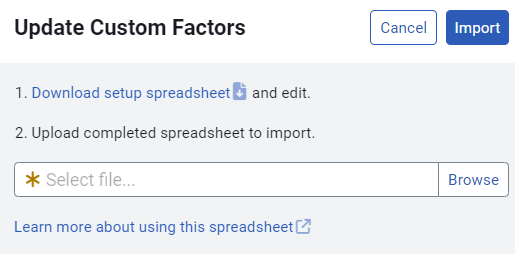Custom factors spreadsheet
This spreadsheet lets you create custom factors that can be used in place of system factors for calculating GHG emissions records.
Benefits of spreadsheets
Spreadsheets save time and let you create multiple items at one time.
- The menu displays spreadsheets matching your permissions.
- Always download a new spreadsheet before you begin adding data because the spreadsheet is populated with information from your database.
Format rules
- Enter all information as text or dates.
- You can add sheets to the notebook, only the sheet named DataEntry is processed.
- Do not rename, remove, or rearrange columns.
Maximum length for codes and names
The column header lists the maximum length for each attribute. When entering data, a red cell indicates the name or code exceeding the specified length. If you upload the spreadsheet without fixing the cell, the row fails to process and an error spreadsheet is created.
Steps to update custom factors
- Click the Gear icon.
- Select Custom Factors.
- Download the sheet. Add your information and save the file.
- Select your file to upload.
- Import your spreadsheet to create the custom factors.

The custom factors spreadsheet has a tab that includes all system factors and their version.
You can copy and modify a system factor to create your own custom factor.
Factor Versions
To see examples of factor versions, take a look at the System Factor List tab in CarbonHub. Versions are generally updated on a regular cadence as GWP (global warming potential) or AR values change.
The most recent factor version is the active one.
Versions are useful to monitor GHG changes. Creating versions can help you get more accurate emissions data over time.
Spreadsheet columns
| Column | Rules |
| Factor Name | Helps users to know when this factor should be used. |
| Factor Description | This identifies what makes this factor unique or important. You can view it when downloading a factor spreadsheet or when reviewing the Linked Factors History information available by clicking on a factor when viewing a record. |
| Region | Select a region from the list. |
| Source Organization | Who provided this factor, for example, the EPA. |
| Model | Mathematical model used to calculate the factor. So you can remember how the factor was calculated. For example, Emissions = Fuel x HHV x EF2. |
| Unit Category | Select from a unit category from the list. |
| Unit | Select a unit from the list. This is used by the factor to calculate CO2 equivalence. |
|
Factor in Use? |
Any factors in use cannot be deleted. |
| Delete Unused Factor or Version | Use this column to delete the factor or version. |
| Effective Month | You need all three entries to create a version (month, year, source). |
| Effective Year | Enter the four digit year. |
| Source | Enter the name of the reference document. |
| Gas Type | Select the reportable gas type from the list. At least one gas type is required per version. |
| Gas Amount | Kilograms of gas emitted per commodity source unit. |